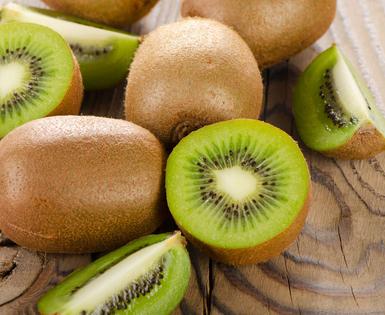Environmental Nutrition: The Quintessential Kiwi
Drab, rough and rather homely looking, kiwifruit is proof that true beauty is on the inside. Kiwi's vibrant green flesh with a dash of tropical flair has been coveted since it was discovered in its native China. Soon known as the Chinese gooseberry, New Zealand growers exported it around the world. A California produce dealer dubbed it kiwifruit in the 1960s because it resembled New Zealand's national bird, the fuzzy brown kiwi! Today, California grows 98 percent of the U.S. supply of this beautiful and nutritious fruit.
There are more than 40 varieties of kiwi, including the golden kiwifruit, but the most common is the Hayward (Actinidia deliciosa). These brown, fuzzy-skinned ovals hide an emerald flesh accented with artistic rings of tiny black edible seeds. Similar in texture to strawberries, kiwis have their own unique, almost tropical, sweet flavor. Kiwis are small in stature, but big on nutrition. A 1 cup serving has more than two-and-a-half times the recommended daily allowance of antioxidant vitamin C--more than the same amount of orange, and more potassium (16 percent Daily Value) than a medium banana.
Researchers reported that kiwifruit provides high nutrient density, health benefits, and consumer appeal in a study published in the June 2013 Canadian Journal of Physiology and Pharmacology. The scientists referred to kiwi's high levels of vitamins, fiber and phytochemicals, which work together to provide many health benefits, such as strengthening the immune system, digestion and heart health. Kiwi also may help increase the uptake and retention of important minerals, such as iron and calcium, in the body, according to a study in a 2013 Advances in Food and Nutrition Research.
California kiwifruit are harvested from October through May, which complements New Zealand's June through October season, making fresh kiwi available all year. Choose firm, unblemished fruit. They're ready to eat when they give to slight pressure. Ripen on the counter for a day or so, where they'll keep for several days, or up to four weeks refrigerated. Enjoy kiwi sliced or scooped with a spoon from two halves, tossed in salads, added to a fruit tart or as a gorgeous and delicious garnish on a drink or dessert.
Notable Nutrients
Kiwifruit, raw (1 cup, 177 g)
Calories: 108
Dietary fiber: 5 g (21 percent DV)
Vitamin C: 164 mg(273 percent DV)
Vitamin E: 2.6 mg (13 percent DV)
Vitamin K: 71 mcg (89 percent DV)
Folate: 44 mcg (11 percent DV)
Potassium: 552 mg (16 percent DV)
Copper: 0.2 mg (12 percent DV)
(Environmental Nutrition is the award-winning independent newsletter written by nutrition experts dedicated to providing readers up-to-date, accurate information about health and nutrition in clear, concise English. For more information, visit www.environmentalnutrition.com.)







